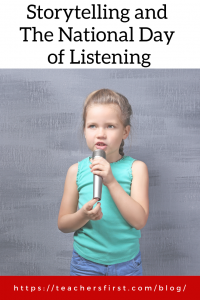November 27 is the National Day of Listening. Celebrated each year on the day after Thanksgiving, it’s a time to gather families and friends for the specific purpose of recording and sharing histories and stories for preservation. Launched in 2008 by StoryCorps (reviewed here), this observance falls at a time when many families are together, offering the opportunity to share family stories without the distractions of work and school commitments.
This article from The Atlantic describes the ways children benefit from hearing stories told by their parents. The author shares how modeling storytelling using detailed information helps kids become better storytellers. The social and emotional benefits are also evident: learning from family stories helps children develop stronger self-identities and build solid connections to family members.
Unfortunately, not all students come from a strong family structure that allows for generational storytelling. Their strongest family bond might be in our classrooms, built within our classroom community support systems. In addition, many students find family in relationships with peers and through interactions with teachers and school staff.
Consider ways to adapt the National Day of Listening into a classroom storytelling lesson that begins with your class family. Think about the shared experiences so far this school year. Have your students participated in a memorable learning activity? Does your school build community through pep rallies, rewards for earning points, or special dress-up days? Many schools participate in the RCA House System to build character and school spirit. These activities provide a sense of school family and inclusion for students and serve as a starting point for creating family stories.
It is essential to expose students to different oral storytelling models to help them recognize what makes a story interesting. Sometimes it’s the delivery and intonation of voice; other times, it’s the choice of words and building the story through the gradual lead-up to the climax, then ending with a satisfying conclusion.
One way to model storytelling is through the use of podcasts. These podcasts feature rich storytelling experiences for students of all ages:
- Circle Round Podcast (reviewed here) – This podcast for grades K–6 adapts folk-tales from all over the world into entertaining listening experiences built upon themes like friendship and persistence. Circle Round adds episodes weekly.
- Stuff You Missed in History Class (reviewed here) – Through the unique storytelling skills of hosts, this podcast for grades 7–12 shares stories from history that might otherwise be overlooked or appear to be uninteresting. For example, recent episodes share the story behind the invention of the telescope and the tale of three upbeat cats that take their place in history.
- Greeking Out – Learn about Greek myths through this podcast for grades 6–12 about the Zeus the Mighty book series. Episodes from the first season share stories of Phaethon’s voyage to meet the father he never knew and Jason’s quest for the golden fleece.
After exposing students to different storytelling models, put their understanding into practice using digital tools to create your ongoing class history. Wakelet (review here) recently added a new column feature that’s perfect for building and sharing your stories. Easily add multiple columns to any collection, such as a column for each month of the school year and add students’ publications. Import students’ video stories quickly from YouTube (reviewed here), Flipgrid (reviewed here), Google Drive (reviewed here), and Adobe Spark for Education (reviewed here) without having to leave Wakelet.
Sharing classroom stories is an excellent way to build classroom community, share your class history, and build storytelling skills in meaningful ways. Consider starting your classroom history as you recognize the National Day of Listening this year.


